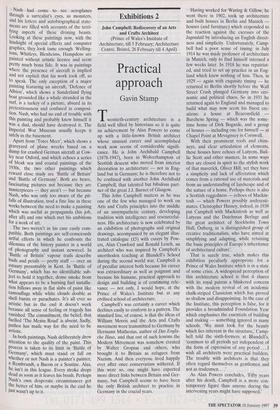Exhibitions 2
John Campbell: Rediscovery of an Arts and Crafts Architect (Prince of Wales's Institute of Architecture, till 5 February; Architecture Centre, Bristol, 26 February till 4 April)
Practical approach
Gavin Stamp
wentieth-century architecture is a field well tilled by historians so it is quite an achievement by Alan Powers to come up with a little-known British architect whose unusual career and accomplished work now seems of considerable signifi- cance. He is John Archibald Campbell (1878-1947), born in Wolverhampton of Scottish descent who moved from interior decoration to architecture — not in Eng- land but in Germany; he is therefore not to be confused with another John Archibald Campbell, that talented but bibulous part- ner of the great J.J. Burnet of Glasgow.
This John Campbell matters as he was one of the few who managed to work on Arts and Crafts principles into the middle of an unsympathetic century, developing tradition with intelligence and resourceful- ness. His architecture is now celebrated by an exhibition of photographs and original drawings, accompanied by an elegant illus- trated catalogue (£5) with essays by Pow- ers, Alan Crawford and Ronald Leach, an architect who was inspired by Campbell's unorthodox teaching at Blundell's School during the second world war. Campbell is of peculiar interest both because his career was extraordinary as well as poignant and because his humane, practical approach to design and building is of continuing rele- vance — not only, I would hope, at the Prince of Wales's Institute but at any civilised school of architecture.
Campbell's was certainly a career which declines easily to conform to a pattern. The standard line, of course, is that the ideas of William Morris and the Arts and Crafts movement were transmitted to Germany by Hermann Muthesius, author of Das Englis- ehe Haus, and that out of such lessons the Modern Movement was somehow created by Walter Gropius and others, who brought it to Britain as refugees from Nazism. And then everyone lived happily ever after once conservatism withered. If this were so, one might have expected more direct links between Britain and Ger- many, but Campbell seems to have been the only British architect to practise in Germany in the crucial years. Having worked for Waring & Gillow, he went there in 1902, took up architecture and built houses in Berlin and Munich houses (and furniture) which responded to the reaction against the excesses of the Jugendstil by introducing an English direct- ness and simplicity. Unfortunately, Camp- bell had a poor sense of timing: in July 1914 he was made professor of architecture in Munich, only to find himself interned a few weeks later. In 1918 he was repatriat- ed, and tried to set up practice in an Eng- land which knew nothing of him. Then, in 1929 — again with exquisite timing — he returned to Berlin shortly before the Wall Street Crash plunged Germany into eco- nomic and political chaos. So in 1931 he returned again to England and managed to build what may now seem his finest cre- ations: a house at Beaconsfield — Burchens Spring — which was the some- time home of Dirk Bogarde, and a group of houses — including one for himself — at Chapel Point at Mevagissey in Cornwall.
With their prominent roofs and chim- neys, and clear articulation of elements, these houses have echoes of Lutyens, Bail- lie Scott and other masters. In some ways they are closest in spirit to the stylish work of that maverick, Oliver Hill, yet they have a simplicity and lack of affectation which comes from a rational use of materials and from an understanding of landscape and of the nature of a home. Perhaps there is also a Scottish ruggedness — echoes of Mackin- tosh — which Powers possibly underesti- mates. Christopher Hussey, indeed, in 1938 put Campbell with Mackintosh as well as Lutyens and the Dutchman Berlage and the great architect of Stockholm Town Hall, Ostberg, in 'a distinguished group of creative traditionalists, who have aimed at simplifying and adapting, while retaining the basic principles of Europe's inheritance of architectural culture'.
That is surely true, which makes this exhibition peculiarly appropriate for a Prince of Wales Institute which is in a state of some crisis. A widespread perception of this architecture school is that it shares with its royal patron a blinkered concern with the modern revival of an academic chalk-striped Classicism which has proved so shallow and disappointing. In the case of the Institute, this perception is false, for it provides a broadminded Foundation Year which emphasises the essentials of building and making — something ignored in many schools. 'We must look for the beauty which lies inherent in the structure,' Camp- bell told the sixth-formers at Blundell's, `common to all periods yet independent of the form of expression of any period ... I wish all architects were practical builders. The trouble with architects is that they often regard themselves as gentlemen and not as tradesmen ...'
As Alan Powers concludes, 'Fifty years after his death, Campbell is a more con- temporary figure than anyone during the intervening years might have supposed.'


























































 Previous page
Previous page